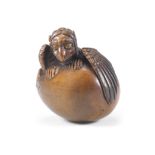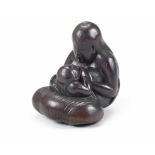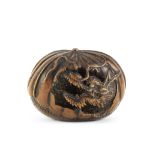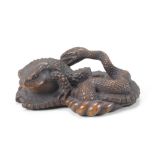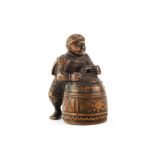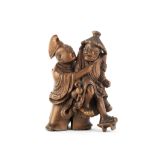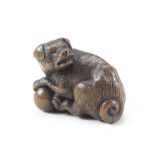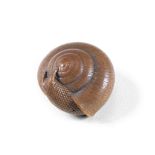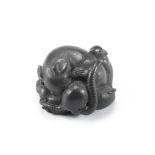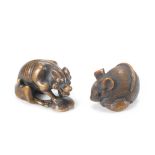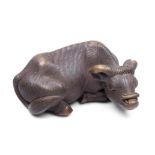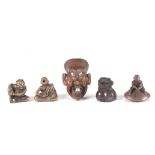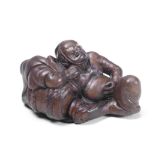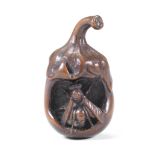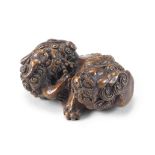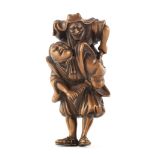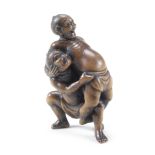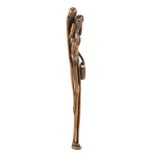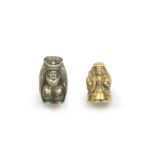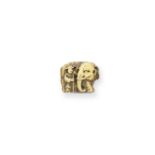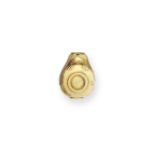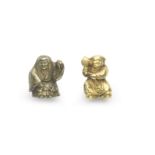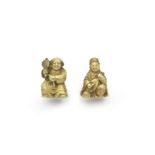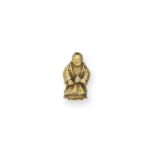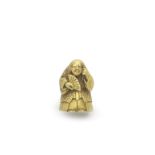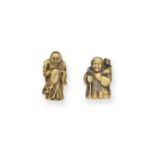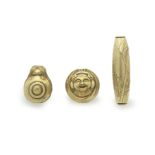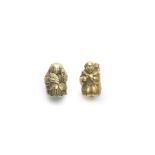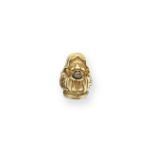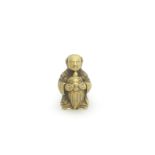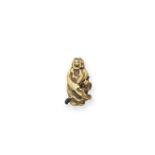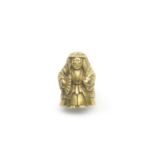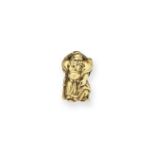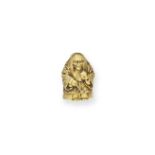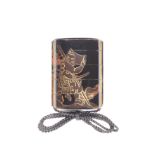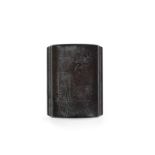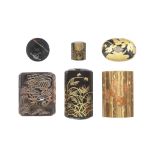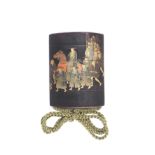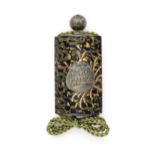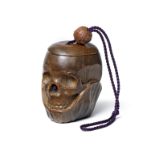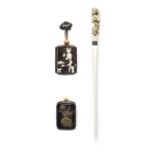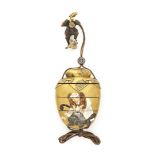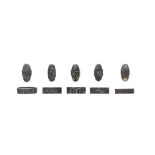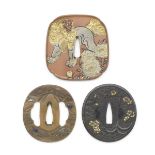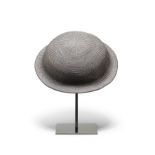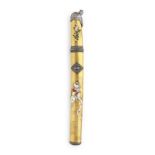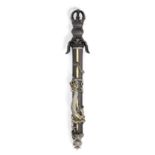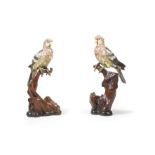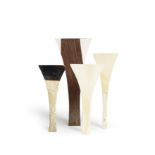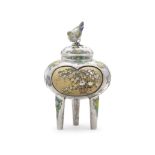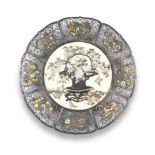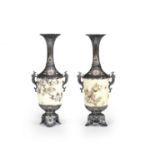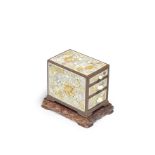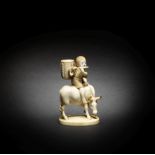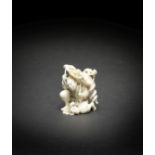Verfeinern Sie Ihre Suche
Kategorie
- Japanese Works of Art (230)
- Prints (33)
- Chinese Works of Art (15)
- Ceramics (8)
- Watercolours (7)
- Collectables (6)
- Books & Periodicals (5)
- Arms, Armour & Militaria (4)
- Furniture (4)
- Models, Toys, Dolls & Games (4)
- Salvage & Architectural Antiques (4)
- Sculpture (4)
- Metalware (3)
- Oil, Acrylic paintings & Mixed Media (3)
- Maps (2)
- Musical Instruments & Memorabilia (2)
- Textiles (2)
- Vintage Fashion (2)
- Clocks (1)
- Jewellery (1)
- Sporting Memorabilia & Equipment (1)
- Liste
- Galerie
-
341 Los(e)/Seite
Ein Abonnement der Preisliste ist notwendig um Ergebnisse, von Auktionen die vor einem längeren Zeitraum als 10 Tagen stattgefunden haben, ansehen zu können. Klicken Sie hier für mehr Informationen
A wood netsuke of a tengu no tamago (hatching tengu) By Toyoyasu (Toyoyo, 1811-1883), Sasayama, T...
A wood netsuke of a tengu no tamago (hatching tengu)By Toyoyasu (Toyoyo, 1811-1883), Sasayama, Tanba Province, Edo period (1615-1868), early 19th ...
A netsuke of a suckling mermaid By Masakazu, Edo period (1615-1868) or Meiji era (1868-1912), cir...
A netsuke of a suckling mermaidBy Masakazu, Edo period (1615-1868) or Meiji era (1868-1912), circa 1860-1880The mermaid seated with a serene expre...
A wood netsuke of a dragon in a chestnut By Toyoyasu (Toyoyo), Edo period (1615-1868), Sasayama, ...
A wood netsuke of a dragon in a chestnutBy Toyoyasu (Toyoyo), Edo period (1615-1868), Sasayama, Tanba Province, 19th centuryThe small chestnut nat...
A netsuke of an oni (demon)By Miwa, Edo, Edo period (1615-1868), circa 1820The oni reclining, grinning, his right elbow resting on his right knee,...
A large boxwood netsuke of a toad and snake By Masanao, Ise, Yamada, Edo period (1615-1868), mid...
A large boxwood netsuke of a toad and snakeBy Masanao, Ise, Yamada, Edo period (1615-1868), mid-19th centuryThe unsuspecting toad sitting at one e...
A Wood netsuke of Benkei and the bell of MiideraEdo period (1615-1868), early 19th centuryThe warrior monk shown leaning forward and putting all h...
A wood group netsuke of Taira no Tadamori apprehending the oil thief Edo period (1615-1868), late...
A wood group netsuke of Taira no Tadamori apprehending the oil thiefEdo period (1615-1868), late 18th/early 19th centuryThe former standing barefo...
A netsuke of a dog with a ballBy Tametaka, Nagoya, Edo period (1615-1868), circa 1820The dog seated, grasping a ball with its left paws, its head ...
A wood netsuke of a snailBy Tadayuki, Nagoya, Edo period (1615-1868), early 19th centuryThe snail emerging from its shell, its optic feelers fully...
An ebony wood netsuke of a group of rats By Horaku, Kyoto, Edo period (1615-1868), 19th century
An ebony wood netsuke of a group of ratsBy Horaku, Kyoto, Edo period (1615-1868), 19th centuryComprising five rats of various sizes, the adult rec...
Two boxwood netsukeOne by Masatomo, Edo period (1615-1868), mid-19th centuryThe first a rat seated and bending over a large chestnut, its forepaws...
A wood netsuke of a recumbent ox By Masanao, Kyoto, Edo period (1615-1868), late 18th century
A wood netsuke of a recumbent oxBy Masanao, Kyoto, Edo period (1615-1868), late 18th centuryLying with its head lowered and turning to the right, ...
Five various wood netsukeEdo period (1615-1868) or Meiji era (1868-1912), 19th centuryComprising: an oni (demon) seated, grasping his leg, a small...
A wood netsuke of a man with a sake barrel By Miwa, Edo, Edo period (1615-1868), late 18th/early ...
A wood netsuke of a man with a sake barrelBy Miwa, Edo, Edo period (1615-1868), late 18th/early 19th centuryPossibly Asahina Saburo, the man seate...
A netsuke of a wasp in a nasubi (aubergine) By Kogetsu, Edo period (1615-1868), early 19th century
A netsuke of a wasp in a nasubi (aubergine)By Kogetsu, Edo period (1615-1868), early 19th centuryThe wasp gnawing a large hole into the squat nasu...
A bamboo netsuke group of two shishi (Chinese mythological lion dogs) Meiji era (1868-1912), late...
A bamboo netsuke group of two shishi (Chinese mythological lion dogs)Meiji era (1868-1912), late 19th/early 20th centuryThe adult recumbent with i...
A wood netsuke of Omori Hikoshichi and Chihaya Edo period (1615-1868), late 18th/early 19th century
A wood netsuke of Omori Hikoshichi and ChihayaEdo period (1615-1868), late 18th/early 19th centuryThe warrior standing and bending over from the w...
A large boxwood netsuke of two sumo wrestlers By Unhodo Masayoshi, Meiji era (1816-1912), circa 1890
A large boxwood netsuke of two sumo wrestlersBy Unhodo Masayoshi, Meiji era (1816-1912), circa 1890Possibly Kawazu Sukeyasu and Matano Kagehisa, t...
A tall wood sashi netsuke of Ashinaga and TenagaEdo period (1615-1868), 19th centuryAshinaga (long legs) standing with one foot pinning down a tu...
Two gold ojime One by Shinro and one by Katsuo, Meiji era (1868-1912), late 19th/early 20th centu...
Two gold ojimeOne by Shinro and one by Katsuo, Meiji era (1868-1912), late 19th/early 20th centuryThe first a Shishimai dancer, lifting his lion h...
A gold ojime of a boy and an elephant By Shumin, Meiji era (1868-1912), late 19th/early 20th century
A gold ojime of a boy and an elephantBy Shumin, Meiji era (1868-1912), late 19th/early 20th centuryThe boy standing, dressed in Mongol-style attir...
A gold ojime of DarumaMeiji era (1868-1912), late 19th/early 20th centuryDaruma standing, turning slightly to his left with an alert expression on...
A gold ojime of a Shojo (drunken spirit)Meiji era (1868-1912), late 19th/early 20th centuryPeeping from behind a large sakazuki (sake cup), his lo...
Two gold ojime One by Katsuhira and one by Shosai, Meiji era (1868-1912), late 19th/early 20th ce...
Two gold ojimeOne by Katsuhira and one by Shosai, Meiji era (1868-1912), late 19th/early 20th centuryThe first Daikoku standing, brandishing his m...
Two gold ojime One by Katsuo and one by Shuraku, Meiji era (1868-1912), late 19th/early 20th cent...
Two gold ojimeOne by Katsuo and one by Shuraku, Meiji era (1868-1912), late 19th/early 20th centuryThe first Daikoku, standing, brandishing his ma...
A gold ojime of a Noh actorBy Katsuo, Meiji era (1868-1912), late 19th/early 20th centuryAssuming a female role, the actor standing, wearing a fem...
A gold ojime of a Shojo (drunken spirit) dancer By Katsuo, Meiji era (1868-1912), late 19th/early...
A gold ojime of a Shojo (drunken spirit) dancerBy Katsuo, Meiji era (1868-1912), late 19th/early 20th centuryThe dancer standing, holding a lock o...
Two gold ojimeOne by Katsuo, Meiji era (1868-1912), late 19th/early 20th centuryThe first a rakan (disciple of Buddha), standing with a severe exp...
Three gold ojime One by Ryumin, one by Kansosei and one by Katsuhira, Meiji era (1868-1912), late...
Three gold ojimeOne by Ryumin, one by Kansosei and one by Katsuhira, Meiji era (1868-1912), late 19th/early 20th centuryThe first a Shojo (drunken...
Two gold ojimeBy Katsuo, Meiji era (1868-1912), late 19th/early 20th centuryThe first a Shojo dancer standing, holding a lock of hair in one hand ...
A gold ojime of JurojinBy Shomin, Meiji era (1868-1912), late 19th/early 20th centuryJurojin standing, bearing a serene expression, holding a tama...
A gold ojime of a Karako (Chinese boy) By Masatoshi, Meiji era (1868-1912), late 19th/early 20th ...
A gold ojime of a Karako (Chinese boy)By Masatoshi, Meiji era (1868-1912), late 19th/early 20th centuryThe karako standing with a serene expressio...
A gold ojime of JittokuMeiji era (1868-1912), late 19th/early 20th centuryJittoku standing and laughing, his robes decorated with clouds, holding ...
A gold ojime of a Shojo (drunken spirit) dancer By Katsuhira, Meiji era (1868-1912), late 19th/ea...
A gold ojime of a Shojo (drunken spirit) dancerBy Katsuhira, Meiji era (1868-1912), late 19th/early 20th centuryThe dancer standing, wearing a wid...
A gold ojime of Shoki the Demon-Queller By Ryumin, Meiji era (1868-1912), late 19th/early 20th ce...
A gold ojime of Shoki the Demon-QuellerBy Ryumin, Meiji era (1868-1912), late 19th/early 20th centuryShoki standing with a fierce expression, his ...
Two gold ojime One by Katsuhira and one by Kiyotoshi, Meiji era (1868-1912), late 19th/early 20th...
Two gold ojimeOne by Katsuhira and one by Kiyotoshi, Meiji era (1868-1912), late 19th/early 20th centuryThe first Daikoku, standing, brandishing h...
A gold ojime of a Noh actorBy Katsuo, Meiji era (1868-1912), late 19th/early 20th centuryAssuming the role of Kiyohime in the play Dojoji, the act...
A lacquer three-case inroEdo period (1615-1868), 16th/17th centuryThe roiro ground lacquered with a continuous scene in gold and slightly coloured...
A yamimaki-e (black-on-black) lacquer four-case inro By a member of the Kajikawa family, Edo peri...
A yamimaki-e (black-on-black) lacquer four-case inroBy a member of the Kajikawa family, Edo period (1615-1868), 19th centuryThe rich roiro ground ...
A group of various netsuke and inro The second inro by a member of the Kajikawa family, the third...
A group of various netsuke and inroThe second inro by a member of the Kajikawa family, the third inro by Haruyoshi, the third netsuke by Tatsumi M...
A black-lacquer four-case inro By Koma Kyuhaku, Edo period (1615-1868), late 18th/early 19th cen...
A black-lacquer four-case inroBy Koma Kyuhaku, Edo period (1615-1868), late 18th/early 19th centuryThe roiro ground finely decorated in gold, silv...
A black lacquer four-case inro By Shojusai, Edo period (1615-1868) or Meiji era (1868-1912), 19th...
A black lacquer four-case inroBy Shojusai, Edo period (1615-1868) or Meiji era (1868-1912), 19th centuryBearing a roiro and e-nashiji ground, lac...
A tsugaru-nuri lacquer four-case inro Style of Ogawa Haritsu (Ritsuo, 1663-1747), Edo period (161...
A tsugaru-nuri lacquer four-case inroStyle of Ogawa Haritsu (Ritsuo, 1663-1747), Edo period (1615-1868), late 18th/early 19th centuryThe tsugaru-n...
A wood tonkotsu (tobacco box)Edo period (1615-1868), first half of the 19th centuryThe tonkotsu in the form of a skull, the mandible of exaggerate...
Three inro and an ivory paper knife Taisho (1912-1926) or Showa (1926-1989) era, early/mid-20th c...
Three inro and an ivory paper knifeTaisho (1912-1926) or Showa (1926-1989) era, early/mid-20th centuryComprising: the first a wood three-case inro...
A gold-lacquered and Shibayama inlaid three-case inro in the form of a chatsubo (tea jar) and a w...
A gold-lacquered and Shibayama inlaid three-case inro in the form of a chatsubo (tea jar) and a wood and ivory netsukeThe inro: Meiji era (1868-19...
Five fuchi-gashira (matching hilt collars and pommels) Edo period (1615-1868), late 18th/19th cen...
Five fuchi-gashira (matching hilt collars and pommels)Edo period (1615-1868), late 18th/19th centuryAll shibuichi except the fifth, inlaid in mix...
Three tsuba (sword guards) Edo period (1615-1868) to Showa era (1926–1989), 19th/20th centu...
Three tsuba (sword guards)Edo period (1615-1868) to Showa era (1926–1989), 19th/20th centuryThe first brightly patinated copper mokko with a hamme...
A jingasa (war hat)Edo period (1615-1868) or Meiji era (1868-1912), 19th centuryOf bajo (horse riding) type, constructed from woven fibre stiffene...
A gold-lacquered and Shibayama inlaid tanto koshira-e (mounting for a short sword) Attributed to ...
A gold-lacquered and Shibayama inlaid tanto koshira-e (mounting for a short sword)Attributed to Shibayama Yasumasa (Ekisei), Meiji era (1868–1912)...
A finely mounted mixed-metal aikuchi tanto (Dagger with flush-fitting hilt and scabbard) Meiji er...
A finely mounted mixed-metal aikuchi tanto (Dagger with flush-fitting hilt and scabbard)Meiji era (1868-1912), late 19th/early 20th centuryThe tsu...
A pair of shibayama-style and ivory-inlaid parrots By Kiyotoshi, Meiji era (1868-1912), late 19th...
A pair of shibayama-style and ivory-inlaid parrotsBy Kiyotoshi, Meiji era (1868-1912), late 19th/early 20th centuryThe plumage and tail of both bi...
A collection of four bachi (plectrums)Edo period (1615-1868), probably mid-19th century Comprising four plectrums of different sizes and materials...
A silver-mounted and Shibayama-style spherical koro (incense burner) and cover Meiji era (1868-19...
A silver-mounted and Shibayama-style spherical koro (incense burner) and coverMeiji era (1868-1912), late 19th/early 20th centuryThe body inset wi...
An ivory Shibayama-inlaid and enamelled silver-filigree dish By Masayoshi, Meiji era (1868-1912),...
An ivory Shibayama-inlaid and enamelled silver-filigree dishBy Masayoshi, Meiji era (1868-1912), late 19th/early 20th centuryRaised on three tripo...
A pair of silver-mounted, enamelled and Shibayama-inlaid ivory vases By Gassan, Meiji era (1868-1...
A pair of silver-mounted, enamelled and Shibayama-inlaid ivory vasesBy Gassan, Meiji era (1868-1912), late 19th/early 20th centuryEach vase with a...
A Shibayama-style and ivory-inlaid rectangular kodansu (small cabinet) Meiji era (1868-1912), lat...
A Shibayama-style and ivory-inlaid rectangular kodansu (small cabinet)Meiji era (1868-1912), late 19th/early 20th centuryThe exterior inlaid with...
An ivory okimono of a boy on an ox By Hozan, Meiji era (1868-1912), late 19th/early 20th century
An ivory okimono of a boy on an oxBy Hozan, Meiji era (1868-1912), late 19th/early 20th centuryThe young oxherd seated on the back of an ox playin...
An ivory small okimono of a Yamabushi priest By Kogyoku, Meiji era (1868-1912), late 19th/early ...
An ivory small okimono of a Yamabushi priestBy Kogyoku, Meiji era (1868-1912), late 19th/early 20th centuryKneeling in front of a tiny oni (demon)...
Three ivory okimonoMeiji era (1868-1912), late 19th/early 20th centuryThe first a court musician, standing, his court robe decorated with clouds a...
-
341 Los(e)/Seite


